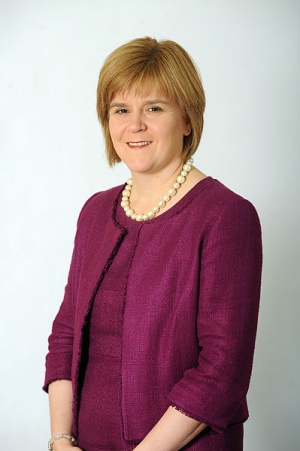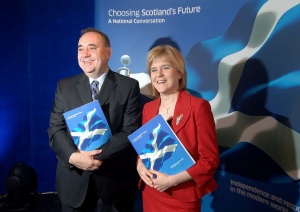Difference between revisions of "Nicola Sturgeon"
(Update) |
(→Scottish independence: Adding image) |
||
| Line 38: | Line 38: | ||
===Scottish independence=== | ===Scottish independence=== | ||
| − | + | [[File:Salmond_Sturgeon.jpg|300px|right|thumb|Scottish First Minister, [[Alex Salmond]], and Deputy FM, Nicola Sturgeon, at the launch of the "National Conversation" (14 August 2007)]] | |
Nicola Sturgeon joined the SNP at the age of sixteen, and has been working for an independent Scotland ever since. In 2012, Sturgeon was appointed to persuade Scottish voters to vote "Yes" in the 2014 Referendum on Scottish independence. Sturgeon has insisted that independence would allow Scotland to build a stronger and more competitive country.<ref>[http://www.guardian.co.uk/politics/2012/may/25/scotland-independence-economy-grow-sturgeon "Scotland's Independence"]</ref> | Nicola Sturgeon joined the SNP at the age of sixteen, and has been working for an independent Scotland ever since. In 2012, Sturgeon was appointed to persuade Scottish voters to vote "Yes" in the 2014 Referendum on Scottish independence. Sturgeon has insisted that independence would allow Scotland to build a stronger and more competitive country.<ref>[http://www.guardian.co.uk/politics/2012/may/25/scotland-independence-economy-grow-sturgeon "Scotland's Independence"]</ref> | ||
| − | On 18 September 2014, after a two-year keenly fought campaign, the Scottish independence referendum finally took place. The referendum question, which voters answered with "Yes" or "No", was "Should Scotland be an independent country?" The "No" side won, with 2,001,926 (55.3%) voting against independence.<ref>[http://en.wikipedia.org/wiki/Scottish_independence_referendum,_2014 "2014 Scottish independence referendum"]</ref> | + | On 18 September 2014, after a two-year keenly fought campaign, the Scottish independence referendum finally took place. The referendum question, which voters answered with "Yes" or "No", was "Should Scotland be an independent country?" The "No" side won, with 2,001,926 (55.3%) voting against independence.<ref>[http://en.wikipedia.org/wiki/Scottish_independence_referendum,_2014 "2014 Scottish independence referendum"]</ref> |
==Awards and acknowledgements == | ==Awards and acknowledgements == | ||
Revision as of 12:10, 21 September 2014

Nicola Sturgeon (born 19 July 1970) is a Scottish National Party (SNP) politician who has been the Deputy First Minister of Scotland since 2007 and the Depute Leader of the SNP since 2004. She is also currently the Cabinet Secretary for Parliament and Government Strategy, the Cabinet Secretary for Infrastructure, Investment and Cities, and the Member of the Scottish Parliament (MSP) for Glasgow Southside.[1]
Nicola Sturgeon became an MSP in the first elections to the Scottish Parliament in 1999, becoming the SNP's spokeswoman on justice, and later on education and health. In 2004, she announced that she would stand as a candidate for the leadership of the SNP following the resignation of John Swinney. However, she later withdrew from the contest in favour of Alex Salmond, but stood as Depute Leader on a joint ticket with Salmond. Both were subsequently elected and Sturgeon led the SNP in the Scottish Parliament from 2004–2007 until Salmond was elected back to the Scottish Parliament in the 2007 election.
The SNP won the highest number of seats in the Scottish Parliament following the 2007 election and Salmond was subsequently appointed First Minister of Scotland. He appointed Sturgeon his Deputy First Minister and Cabinet Secretary for Health and Wellbeing. On 21 December 2013, Nicola Sturgeon attended the 25th Anniversary of the Lockerbie air disaster Remembrance Service at Westminster Abbey.
Following the Scottish independence referendum on 18 September 2014, when voters rejected the idea of leaving the United Kingdom by 55% to 45%, Alex Salmond announced his resignation as First Minister and SNP leader. Nicola Sturgeon is widely expected to succeed him as Scottish First Minister.[2]
Contents
Early life
Nicola Sturgeon was born in Irvine, North Ayrshire and educated at Greenwood Academy, Dreghorn, and later studied Scots Law at the University of Glasgow where she graduated with an LLB (Hons) and Diploma in Legal Practice.[3] At university, she was active in the SNP student wing through Glasgow University Scottish Nationalist Association. She worked as a solicitor in the Drumchapel Law Centre in Glasgow before becoming an MSP. She married Peter Murrell, the SNP's Chief Executive, on 16 July 2010. They had announced their engagement on 29 January 2010. Her mother, Joan Sturgeon, is SNP Provost of North Ayrshire Council where she has been councillor for the Irvine East ward since 2007.
Political career
Early political career
Sturgeon joined the Scottish National Party in 1986 and became Youth Affairs Vice Convener and Publicity Vice Convener. She first stood for election in the 1992 UK election as SNP's candidate in the Glasgow Shettleston constituency, and was the youngest parliamentary candidate in Scotland, although she failed to win the seat.
The 1997 general election saw Sturgeon selected to fight the Glasgow Govan seat for the SNP. Boundary changes meant that the notional Labour majority in the seat had increased substantially; however, infighting between the two rival candidates for the Labour nomination, Mohammed Sarwar and Mike Watson, along with an energetic local campaign, resulted in Glasgow Govan being the only Scottish seat to see a swing away from Labour in the midst of a Labour landslide UK-wide.
Scottish Parliament
Sturgeon stood for election to the Scottish Parliament in the 2003 elections for the Glasgow Govan constituency. However she failed to win this constituency on both occasions. However in both elections, she was placed first in the regional list for the Glasgow region and was thus elected as an SNP additional member. She was elected to the SNP national executive, and she was appointed the party's spokeswoman for health, education and later for justice.
2004 SNP leadership contest
On 22 June 2004, John Swinney resigned as leader of the SNP, following poor results in the 2004 European Parliament election]]. His depute, Roseanna Cunningham, announced her intention to stand for the leadership, and previous leader, Alex Salmond stated that he would not stand and refuse nomination.[4] On 24 June 2004, Nicola Sturgeon announced that she would also be a candidate in the forthcoming election for the leadership of the Scottish National Party, with Kenny MacAskill as her running mate for the Depute leadership.[5]
However, Alex Salmond later staged a u-turn and announced he intended to stand (to resume the leadership, which he had resigned in 2000). Sturgeon withdrew from the contest and declared her support for Salmond, standing instead for the depute leadership. It was reported that Salmond had privately supported Sturgeon in her leadership bid, but decided to run for the position himself as it became apparent she was unlikely to beat Roseanna Cunningham.[6] The majority of the SNP hierarchy lent their support to the Salmond-Sturgeon bid for the leadership, although MSP Alex Neil backed Salmond as leader, but refused to endorse Sturgeon as depute leader.[7]
The results of the leadership contest were announced on 3 September 2004, with Salmond and Sturgeon elected as Leader and Depute Leader. As Salmond was still an MP in the House of Commons, Sturgeon would lead the SNP at the Scottish Parliament until the 2007 election, when Salmond was elected as an MSP.[8]
Depute Leader
As leader of the SNP in the Scottish Parliament, Nicola Sturgeon became a high profile figure in Scottish politics, and regularly clashed with the former First Minister, Jack McConnell at First Minister's Question Time. This included rows over the House of Commons' decision to replace the Trident nuclear weapon system; and the SNP's plans to replace council tax in Scotland with a local income tax.[9]
Sturgeon defeated Gordon Jackson with a 4.7% swing to the SNP in the 2007 Scottish Parliamentary election in Glasgow Govan. The SNP won 9,010 votes (41.9%) which was an increase of +10.7% while Labour received 8,266 votes or 38.4%. After the SNP's victory at the 2007 Scottish Parliament Election, Sturgeon was appointed as the Deputy First Minister and Cabinet Secretary for Health and Wellbeing. She is supported in this role by Shona Robison MSP, the Minister for Public Health and Sport and by Alex Neil MSP, the Minister for Housing and Communities.
Acting in her capacity as Scottish Health Secretary Sturgeon has had a key role reporting the Scottish Government's response to the 2009 swine flu outbreak.[10]
In December 2012 at Ferguson Shipbuilders in Port Glasgow, Sturgeon launched the Caledonian MacBrayne hybrid vessel MV Hallaig.[11]
Scottish independence

Nicola Sturgeon joined the SNP at the age of sixteen, and has been working for an independent Scotland ever since. In 2012, Sturgeon was appointed to persuade Scottish voters to vote "Yes" in the 2014 Referendum on Scottish independence. Sturgeon has insisted that independence would allow Scotland to build a stronger and more competitive country.[12]
On 18 September 2014, after a two-year keenly fought campaign, the Scottish independence referendum finally took place. The referendum question, which voters answered with "Yes" or "No", was "Should Scotland be an independent country?" The "No" side won, with 2,001,926 (55.3%) voting against independence.[13]
Awards and acknowledgements
Sturgeon won the Scottish Politician of the Year Award in 2008. In 2004 and 2008 she also won the Donald Dewar Debater of the Year award at the same event which is organised by The Herald newspaper.
In February 2013 she was assessed as the 20th most powerful woman in the United Kingdom by Woman's Hour on BBC Radio 4.[14]
Personal life
Nicola currently lives in Glasgow with her husband Peter Murrell, who is the current chief executive of the Scottish National Party (SNP).
References
- ↑ "Nicola Sturgeon MSP"
- ↑ "Statement from First Minister Alex Salmond"
- ↑ "Candidates and Constituency Assessments". Alba.org.uk. Retrieved 2011-01-17.Page Module:Citation/CS1/styles.css must have content model "Sanitized CSS" for TemplateStyles (current model is "Scribunto").
- ↑ "Under-fire SNP leader resigns". BBC News. 2004-06-22. Retrieved 2011-01-17.Page Module:Citation/CS1/styles.css must have content model "Sanitized CSS" for TemplateStyles (current model is "Scribunto").
- ↑ "Sturgeon contests SNP leadership". BBC News. 2004-06-24. Retrieved 2011-01-17.Page Module:Citation/CS1/styles.css must have content model "Sanitized CSS" for TemplateStyles (current model is "Scribunto").
- ↑ Swanson, Ian. "Edinburgh News- "Salmond in shock bid for leader"". Edinburghnews.scotsman.com. Retrieved 2011-01-17.Page Module:Citation/CS1/styles.css must have content model "Sanitized CSS" for TemplateStyles (current model is "Scribunto").
- ↑ Denholm, Andrew. "Scotsman.com- "Salmond's arch-rival buries hatchet with declaration of support"". Thescotsman.scotsman.com. Retrieved 2011-01-17.Page Module:Citation/CS1/styles.css must have content model "Sanitized CSS" for TemplateStyles (current model is "Scribunto").
- ↑ "Salmond named as new SNP leader". BBC News. 2004-09-03. Retrieved 2011-01-17.Page Module:Citation/CS1/styles.css must have content model "Sanitized CSS" for TemplateStyles (current model is "Scribunto").
- ↑ "Parties clash on Trident and tax". BBC News. 2007-03-15. Retrieved 2011-01-17.Page Module:Citation/CS1/styles.css must have content model "Sanitized CSS" for TemplateStyles (current model is "Scribunto").
- ↑ "news.bbc.co.uk". news.bbc.co.uk. 2009-04-27. Retrieved 2011-01-17.Page Module:Citation/CS1/styles.css must have content model "Sanitized CSS" for TemplateStyles (current model is "Scribunto").
- ↑ Nicola Sturgeon launches pioneering hybrid ferry from Port Glasgow shipyard
- ↑ "Scotland's Independence"
- ↑ "2014 Scottish independence referendum"
- ↑ "BBC Radio 4, Woman's Hour Power list"
External links
Wikipedia is not affiliated with Wikispooks. Original page source here